Choosing the Right Blade or Line for Your Brushcutter or Strimmer
When you’ve got the ideal cutting attachment for your brushcutter or strimmer, it can make a remarkable difference to the efficiency and quality of your work. Whether you’re trimming lawn edges or clearing rough ground, having the right blade or line transforms your machine from a simple garden trimmer into a high-precision tool, purpose-built for exactly the task in hand. To find the correct one, you need to appreciate the different cutting systems available, from standard garden strimmer cord to heavy duty brushcutter blades.
In this guide, we’ll begin by clarifying the differences between a strimmer, brushcutter and clearing saw. We’ll then explore the full range of available cutting options, helping you choose confidently between metal blades, plastic blades, and mowing line, along with the wide array of strimmer head types. By the end, you’ll know precisely which blade or line best suits your work and how a quick strimmer head replacement can revitalise your entire setup.
Strimmer, Brushcutter, or Clearing Saw: What’s the Difference?
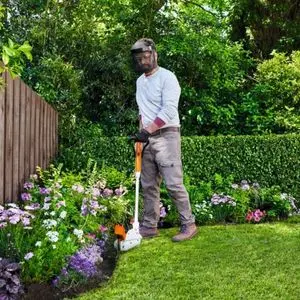 Although some people use the terms interchangeably, these tools serve different purposes. Understanding the difference between a strimmer, brushcutter, and clearing saw is essential before choosing the right cutting attachment.
Although some people use the terms interchangeably, these tools serve different purposes. Understanding the difference between a strimmer, brushcutter, and clearing saw is essential before choosing the right cutting attachment.
Strimmers
A strimmer, often called a grass trimmer, is generally supplied with a curved or lightweight straight shaft and is designed for lawn edges, light weeds, and general domestic garden tidying. As a strimmer typically uses flexible line, it excels in tight spaces and around obstacles, making it ideal for working close to stonework, fencing, or tree trunks. A grass trimmer is not built for heavy vegetation, which is why its cutting options are more limited.
Brushcutters
 The main difference between strimmer and brushcutter tools is that the latter are designed for tougher vegetation and have the strength to run metal blades as well as heavier strimmer brush head line. The shaft is straight and powered by a more robust drive system, allowing torque to transfer more effectively to the cutting attachment. This makes a heavy duty brushcutter capable of working through overgrown areas, brambles, thicker grasses and saplings when used with the correct brushcutter heads. It is far more adaptable than a basic trimmer, with various head brush cutter attachments available for different conditions.
The main difference between strimmer and brushcutter tools is that the latter are designed for tougher vegetation and have the strength to run metal blades as well as heavier strimmer brush head line. The shaft is straight and powered by a more robust drive system, allowing torque to transfer more effectively to the cutting attachment. This makes a heavy duty brushcutter capable of working through overgrown areas, brambles, thicker grasses and saplings when used with the correct brushcutter heads. It is far more adaptable than a basic trimmer, with various head brush cutter attachments available for different conditions.
Clearing Saws
A clearing saw is the most powerful of the three machines. Designed for extensive land management, forestry, and professional clearance work, it operates with high torque and comfortably drives large, multi-tooth metal blades. Clearing saws handle woody shrubs, dense bramble thickets, and even thin trees. They are built for long, continuous sessions rather than occasional garden tidying.
Understanding these distinctions will help ensure you select cutting attachments suited to your tool’s capabilities, preventing excessive wear and improving safety.
Types of Cutting Attachment
The three main types of cutting implement used on brushcutters and strimmers are metal blades, plastic blades, and mowing line.
Metal Blades
Used with brushcutters and clearing saws, metal blades are the most durable and hard-working cutting option, designed for vegetation that flexible line struggles to deal with. They’re available in several forms, including two-tooth, three-tooth, four-tooth, eight-tooth, and circular saw-type options, each blade suited to a different level of resistance.
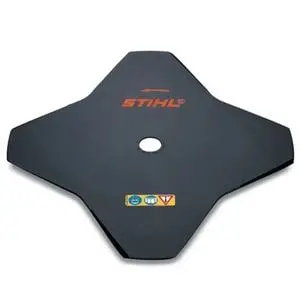 Metal blades come into their own when working through thick grass, tangled brambles, woody weeds and stubborn undergrowth. They slice rather than shred, cutting cleanly even at lower engine speeds, which helps reduce the tool’s vibrations, especially during long working sessions. Because the blade remains rigid, you can work with consistent accuracy, which is especially useful when dealing with large areas of dense vegetation or paddock growth.
Metal blades come into their own when working through thick grass, tangled brambles, woody weeds and stubborn undergrowth. They slice rather than shred, cutting cleanly even at lower engine speeds, which helps reduce the tool’s vibrations, especially during long working sessions. Because the blade remains rigid, you can work with consistent accuracy, which is especially useful when dealing with large areas of dense vegetation or paddock growth.
One of the other main strengths of metal blades is their longevity. They cope well with hard use and provide a neat, controlled finish, especially when the vegetation is too tough for even heavy duty strimmer line or strimmer steel wire alternatives.
There are, however, a few things to bear in mind. Metal blades require a brushcutter powerful enough to drive them, and they must be fitted with a compatible guard. Because the teeth can kick out if they strike a solid object, operators should work carefully and use proper PPE. Blades are not suitable for light trimming around stone or metal obstacles, where a wire strimmer head or flexible line proves far more forgiving.
Plastic Blades
Plastic blades sit neatly between metal blades and nylon line, offering strength without the rigidity of steel. These cutting pieces are commonly used on compact cordless tools and lighter domestic strimmers, providing an attractive balance of durability and safety.
 They are ideal for soft weeds, lawn edges and general tidying in areas where flexible line might wear down too quickly. Plastic blades provide a crisp cut that doesn’t fray, and they maintain consistent length throughout their lifespan. Because they place little strain on the machine, they’re perfectly suited to tools that aren’t built for high-torque work. A strimmer head replacement that uses plastic blades can greatly improve the performance of entry-level models.
They are ideal for soft weeds, lawn edges and general tidying in areas where flexible line might wear down too quickly. Plastic blades provide a crisp cut that doesn’t fray, and they maintain consistent length throughout their lifespan. Because they place little strain on the machine, they’re perfectly suited to tools that aren’t built for high-torque work. A strimmer head replacement that uses plastic blades can greatly improve the performance of entry-level models.
Plastic blades are convenient to replace and handle, making them popular with gardeners who prefer simple maintenance. They also cope better than line when brushing against rough surfaces, which means fewer interruptions to reload the grass trimmer head replacement or spool for strimmer.
However, they do have limits. Plastic blades are not designed for dense or woody vegetation and can snap if they strike solid objects. They can make a practical upgrade from standard line, but they do not replace the power or reliability of metal blades when tackling demanding terrain.
Mowing Line
Mowing line, often referred to as strimmer line, is the most widely used cutting material across domestic gardens. It is available in a range of thicknesses and profiles, from fine line for lawn edges right up to heavy duty strimmer cord for tougher growth. More specialised versions, such as steel wire grass trimmer hybrid materials, also exist for niche applications.
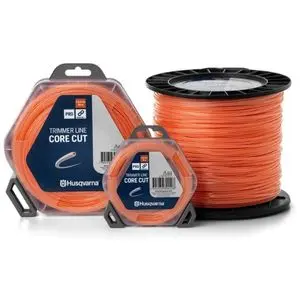 Flexible line is perfect for trimming around trees, posts and paving because it rebounds safely rather than causing damage. It cuts through grass and lighter weeds with ease by whipping at high speed, making it the most forgiving option for everyday work. The fact that it wears down gradually is actually an advantage in most gardens, as it protects both the environment and the operator from sudden kickback.
Flexible line is perfect for trimming around trees, posts and paving because it rebounds safely rather than causing damage. It cuts through grass and lighter weeds with ease by whipping at high speed, making it the most forgiving option for everyday work. The fact that it wears down gradually is actually an advantage in most gardens, as it protects both the environment and the operator from sudden kickback.
Another major benefit is convenience. Mowing line is inexpensive, easy to store, and quick to load into your chosen mowing head. Whether you need a replacement trimmer head or a simple line trimmer replacement line, the parts are widely available and straightforward to fit. Thicker line provides enhanced durability, while round, square or serrated profiles each offer subtle differences in cutting performance.
As with any flexible material, there are considerations. Mowing line is not designed for woody stems or dense scrub, and it degrades more quickly when working along hard edges such as brickwork or kerbs. The performance also varies depending on the quality and thickness of the line, and overloading a strimmer with heavy duty strimmer line can reduce efficiency on small, low-power models.
Understanding Mowing Heads
The mowing head is the mechanism that holds the line (or in some cases, blades). Different strimmer head types provide different levels of control, convenience, and durability. The right choice depends on where you work, how often you use the machine, and how much line you typically go through.
 A bump-feed head is one of the most common designs, often found on both garden strimmers and brushcutters. By lightly tapping the head on the ground, additional line feeds out automatically from the spool. The benefit of this design is its simplicity and speed, particularly when strimming large areas.
A bump-feed head is one of the most common designs, often found on both garden strimmers and brushcutters. By lightly tapping the head on the ground, additional line feeds out automatically from the spool. The benefit of this design is its simplicity and speed, particularly when strimming large areas.
An auto-feed or automatic head advances line without the operator touching the ground, adjusting itself as the line wears down. For regular domestic use, this can be the most effortless system, requiring minimal attention while providing a consistently even cut.
A manual-feed head requires you to pull the line through by hand, making it a low-maintenance option for basic strimmers. It is favoured by occasional users who prefer simple equipment and don’t need the rapid feed options offered by bump or auto-feed systems.
For heavier work, there are brushcutter blade heads. These fixed mounting points allow metal blades or more substantial strimmer brush head attachments to be fitted securely to the machine, offering stability and strength even in dense ground.
There are also more specialised options, such as types of heavy duty strimmer head designed for reinforced line. A line trimmer replacement head may support thicker materials, serrated line pieces or alternative cutting inserts depending on your needs. The key is always compatibility: your chosen head must match the diameter of your line, the power of your machine and the type of vegetation you intend to cut.
Choosing with Confidence
The ideal cutting system depends entirely on your garden and the vegetation you face. Metal blades are unmatched for heavy growth, plastic blades offer a neat middle ground, and mowing line remains unbeatable for everyday trimming and work around delicate surfaces. The sheer number of brushcutter heads and string trimmer head replacement options available means you can tune your machine perfectly for your environment, improving both comfort and efficiency.
 Welcome to the Home of Brushcutters & Strimmers
Welcome to the Home of Brushcutters & Strimmers
Here, at Ron Smith & Co, we sell an exceptional range of brushcutters and strimmers for every type of garden, from compact models for domestic trimming to powerful professional tools capable of clearing stubborn undergrowth. We also supply a huge range of accessories to go with these machines, including metal blades & fixing kits, mowing line, shoulder harnesses, strimmer heads, and trimmer guards—in short, everything you might need to keep your strimmer or brushcutter performing at its best.
And if you need help choosing between different strimmers, picking the best line trimmer replacement head, or have any other questions, please get in touch with our friendly team, who will be delighted to offer you their expert advice.

